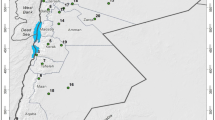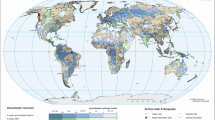Abstract
Apart from being an important natural water resource, groundwater serves as an alternative source of water supply during natural droughts. Groundwater nevertheless has been increasingly threatened by urbanization, industrialization, seasonal climate variability, and climate change. One of the long-term adverse impacts of climate change is an irreversible change in the precipitation intensity and pattern and subsequently a fluctuation in groundwater recharge and hence subsurface storage. In Thailand especially the eastern region of the country where droughts are perennial, reduced precipitation contributes to shortages of water supply in many agricultural areas and industrial estates in the region. The aims of this research are to identify hotspots and prioritize zones presently threatened by persistent droughts and whose subsurface systems are susceptible and vulnerable to climate change. Thus, exposure index is defined by the change of future rainfall from a GCM model, sensitivity index is assessed by a modified DRASTIC technique, and the adaptive capacity in this region is associated with the current occurrence of seasonal droughts. The exposure, sensitivity, and adaptive capacity factors are combined and ranked through the straightforward overlay matrix technique. The results are presented in the form of hazard, impact and vulnerability maps with hotspots and are useful for better groundwater management and planning as well as policy decision-making.







Similar content being viewed by others
References
Aller L, Bennett T, Lehr JH, Petty RJ, Hackett G (1987) DRASTIC: a standardized system for evaluating groundwater pollution potential using hydrogeologic settings. United States Environment Protection Agency, Oklahoma 74820 EPA 600/2-85/018
Al-Rawabdeh AM, Ansari NA, Taani AA, Khateeb FL, Khutsson S (2014) Modeling the risk of groundwater contamination using modified DRASTIC and GIS in Amman-Zerqa Basin, Jordan. Cent Eur J Phys 4(3):364–380
Alwathaf Y, Mansouri BE (2011) Assessment of aquifer vulnerability based on GIS and ARCGIS Methods: a case study of the Sana’s Basin (Yemen). J Water Resour Proj 3:845–855
Anornu GK, Kabo-bah AT (2013) Evaluation of AVI and DRASTIC methods for groundwater vulnerability mapping. J Environ Ecol. doi:10.5296/jee.v4i2.4961
Anornu GK, Kabo-bah AT, Anim-Gyampo M (2012) Evaluation of groundwater vulnerability in the Densu River Basin of Ghana. Am J Hum Ecol 1(3):79–86
Babiker IS, Mohamed AAM, Hiyama T, Kato K (2005) A GIS-based DRASTIC model for assessing aquifer vulnerability in Kakamigahara Heights, Gifu Prefecture, Central Japan. Sci Total Environ 345:127–140
Bates BC, Kundzewicz ZW, Wu S, Palutikof JP (2008) Climate change and water. Technical Paper of the International Panel of Climate Change, Geneva
Changnon S (1987) Detecting drought conditions in Illinois. Illinois State Water Survey Circular 169
Foster S, Marcella M, Karin L, Hector G, Albert T (2003) Utilization of non-renewable groundwater: a socially-sustainable approach to resource management. World Bank. http://documents.worldbank.org/curated/en/2003/01/5161421/utilization-non-renewable-groundwater-socially-sustainable-approach-resource-management. Accessed 26 Oct 2014
Gogu RC, Dassargues A (2005) Current trends and future challenges in groundwater vulnerability assessment using overlay and index methods. Environ Geol 39:549–559
Green TR, Taniguchi M, Kooi H, Gurdak JJ, Allen DM, Hiscock KM, Treidel H, Aureli A (2011) Beneath the surface of global change: Impacts of climate change on groundwater. USDA-ARS/UNL Faculty Paper 851
Hasiniaina F, Zhou J, Guoyi L (2010) Regional assessment of groundwater vulnerability in Tamtsag Basin, Mongolia using DRASTIC model. J Am Sci 6(11):65–78
Hiscock K, Sparkes R, Hodgens A (2012) Evaluation of future climate change impacts on European groundwater resources. In: Treidel H, Martin-Bordes JJ, Gurdak JJ (eds) Climate change effects on groundwater resources: a global synthesis of findings and recommendations. Taylor & Francis Publishing, New York, pp 351–366
Intergovernmental Panel on Climate Change (IPCC) (2001) Climate change 2001: impacts, adaptation and vulnerability. Working group II, Third Assessment Report. http://www.ipcc.ch/ipccreports/tar/wg2/. Accessed 26 Oct 2014
Intergovernmental Panel on Climate Change (IPCC) (2007) Climate change 2001: impacts, adaptation and vulnerability. Working group II, Fourth Assessment. http://www.ipcc.ch/pdf/assessment-report/ar4/wg2/ar4_wg2_full_report.pdf. Accessed 26 Oct 2014
Lima ML, Zelaya K, Massone H (2011) Groundwater vulnerability assessment combining the DRASTIC and DYNA-Clue model in the Argentine pampas. Environ Manage 47:828–839
Margat J, Foster S, Droubi A (2006) Concept and importance of non-renewable resources. In: Foster S, Loucks DP (eds) Non-renewable groundwater resources. A guidebook on socially-sustainable management for water-policy makers. UNESCO, Paris, pp 13–24
Mato RAMM (2002) Groundwater pollution in Urban Dar es Salaam, Tanzania: assessing vulnerability and protection priorities. Dissertation, Eindhoven University of Technology
National Research Council (NRC). (1993). Groundwater vulnerability assessment: contamination potential under conditions of uncertainty. National Academy Press, Washington DC. http://www.nap.edu/openbook.php?record_id=2050. Accessed 29 Oct 2014
Pedreira R, Kallioras A, Pliakas F, Gkiougkis I, Schuth C (2014) Groundwater vulnerability assessment of a coastal aquifer system at River Nestos eastern Delta. Environ Earth Sci, Greece. doi:10.1007/s12665-014-3864-7
Scanlon BR, Jolly I, Sophocleous M, Zhang L (2007) Global impacts of conversions from natural to agricultural ecosystems on water resources: quantity versus quality. Water Resour Res. doi:10.1029/2006WR005486
Seeboonruang U (2014) An empirical decomposition of deep groundwater time series and possible link to climate variability. Global Nest J 16(1):87–103
Taylor RG, Scanlon B, Doll P, Rodell M, van Beek R, Wada Y, Longuevergne L, Leblanc M, Famiglietti JS, Edmunds M, Konikow L, Green TR, Chen J, Taniguchi M, Bierkens MFP, MacDonald A, Fan Y, Maxwell RM, Yechieli Y, Gurdak JJ, Allen D, Shamsudduha M, Hiscock K, Yeh PJF, Holman I, Treidel H (2012) Ground water and climate change. Nat Clim Change. doi:10.1038/nclimate1744
United Nations Office for Disaster Risk Reduction (UNISDR) (2004) Living with risk: a global review of disaster reduction initiatives. http://www.unisdr.org/we/inform/publications/657. Accessed 30 Oct 2014
United Nations Office for Disaster Risk Reduction (UNISDR) (2009) Global assessment report on disaster risk reduction: summary and recommendations: risk and poverty in a changing climate. http://www.unisdr.org/we/inform/publications/9413. Accessed 30 Oct 2014
Vrba J, Zaporozec A (1994) Guidebook on mapping groundwater vulnerability. International contributions to hydrogeology 16. Heise, Hannover
Wallace L, Sundaram B, Brodie RS, Marshall S, Dawson S, Jaycock J, Stewart G (2012) Vulnerability assessment of climate change impacts on groundwater resources in Timor-Leste. Final Report Record 2012/55. Geoscience Australia, Canberra
Wan L, Xia J, Hong S, Bu H, Ning L, Chen J (2014) Decadal climate variability and vulnerability of water resources in arid regions of Northwest China. Environ Earth Sci. doi:10.1007/s12665-014-3874-5
Yin L, Zhang E, Wang X, Wenninger J, Dong J, Guo L, Huang J (2012) A GIS-based DRASTIC model for assessing groundwater vulnerability in the Ordos Plateau, China. Environ Earth Sci 69(1):171–185
Acknowledgments
The author would like to express sincere appreciation to Thailand Office of Natural Resources and Environmental Policy and Planning, for useful reports and data. Appreciation also goes to the project research assistants, Mr. Tarit Rongviriyapanich and Mr. Wattana Laosinwattana, for GIS database management and graphics.
Author information
Authors and Affiliations
Corresponding author
Rights and permissions
About this article
Cite this article
Seeboonruang, U. Impact assessment of climate change on groundwater and vulnerability to drought of areas in Eastern Thailand. Environ Earth Sci 75, 42 (2016). https://doi.org/10.1007/s12665-015-4896-3
Received:
Accepted:
Published:
DOI: https://doi.org/10.1007/s12665-015-4896-3




